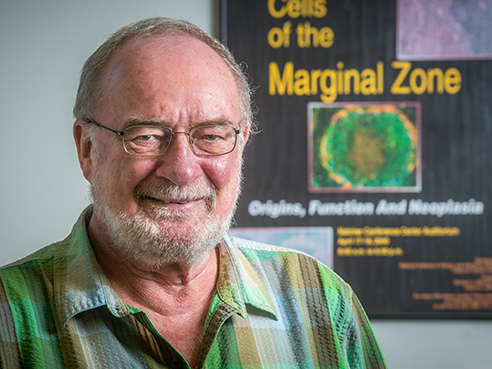 John Kearney, Ph.D., Distinguished Professor and Endowed Professor in Immunology in the Department of MicrobiologyTechnically, John Kearney, Ph.D., has been at UAB for 47 years, despite being honored this year as a 45-year Service Award recipient. Those first two years, he says, don’t count toward his formal employment at UAB; then a postdoctoral fellow, he was supported by a visiting international fellowship during that time following the dental and immunology educations he’d received in Adelaide and Melbourne, Australia.
John Kearney, Ph.D., Distinguished Professor and Endowed Professor in Immunology in the Department of MicrobiologyTechnically, John Kearney, Ph.D., has been at UAB for 47 years, despite being honored this year as a 45-year Service Award recipient. Those first two years, he says, don’t count toward his formal employment at UAB; then a postdoctoral fellow, he was supported by a visiting international fellowship during that time following the dental and immunology educations he’d received in Adelaide and Melbourne, Australia.
From there, he became a research associate in pediatrics before joining the Department of Microbiology in 1976 as assistant professor, and there he stayed. Now, Kearney is a Distinguished Professor and Endowed Professor in Immunology in the Department of Microbiology and holds senior scientist or scientist appointments at UAB’s O’Neal Comprehensive Cancer Center, Center for AIDS Research, Comprehensive Diabetes Center and Comprehensive Arthritis, Musculoskeletal, Bone and Autoimmunity Center.
Kearney will be honored for 45 years of service to UAB during the annual Service Awards banquet March 6, along with more than 280 employees with 20 or more years of service.
The almighty B cell
During his time at UAB, Kearney has studied B cells, also known as B lymphocytes, which are a type of white blood cell that secretes antibodies and fights off common bacteria and viruses. His research through the years has been published in Nature, Immunity, Science, Journal of Immunology, Nature Immunology, Infection and Immunity and more. Overall, he has published more than 230 articles in peer-reviewed publications and about 25 book chapters on various topics in immunology since 1974.
Kearney’s B-cell research has been funded by the National Institutes of Health, the Defense Advanced Research Projects Agency and JDRF, which funds Type 1 diabetes research and advocacy.
|
“We started calling UAB ‘the University of the Almighty B-Cell.’” |
“We started calling UAB ‘the University of the Almighty B-Cell’ after a visitor made a comment about the expertise in that field at UAB,” Kearney said.
One of his current individual NIH grants, which Kearney wrote in his first years as junior faculty, is in its 42nd year of continuous funding — it’s the longest-running NIH grant of its kind at UAB, he says.
“It may outlast me,” Kearney said.
Collaborative nature
The culture upon Kearney’s arrival at 1970s UAB was unique, he says: Many of UAB’s first faculty hires were from other countries who attached less stigma to Birmingham and its history of civil rights injustices.
“Many of us were young then and grew up and matured as scientists together. Many stayed, such as myself,” Kearney said. “People are always collegial here. We were all trying to make the place as good as we could and do the best research we could. Everyone helped each other and it became easy to collaborate and share.”
|
“People are always collegial here. We were all trying to make the place as good as we could and do the best research we could.” |
Combine that with a near-constant construction of new buildings for research labs — Kearney says this “prevented the establishment of scientific fiefdoms and promoted and encouraged cooperation across scientific and medical disciplines” — and you get what he refers to as the “UAB spirit.”
There is free collaboration between departments and cooperation between faculty and trainees is encouraged, Kearney explains. He cites the 2001 anthrax scares as an example; when Gail Cassell, former chair of the Department of Microbiology, first learned of the issue, she wanted to form a DARPA-supported interdisciplinary team to begin conducting research on anthrax. The team formed nearly overnight, Kearney says, with microbiologist Chuck Turnbough, Ph.D., and biochemist Larry DeLucas, O.D., Ph.D., joining forces with other microbiologists and immunologists to study anthrax.
“It happened quickly,” Kearney said. “People were brought into one area, and we successfully researched anthrax together for about 10 years.” The group no longer conducts research together as a team, but it lives on as an example of Kearney’s theory of “the way you can bring people together in the spirit of free-wheeling collaborations” at UAB.
“In my opinion, there is still this spirit of getting things done — a cooperative spirit that pervades the UAB community,” he said.